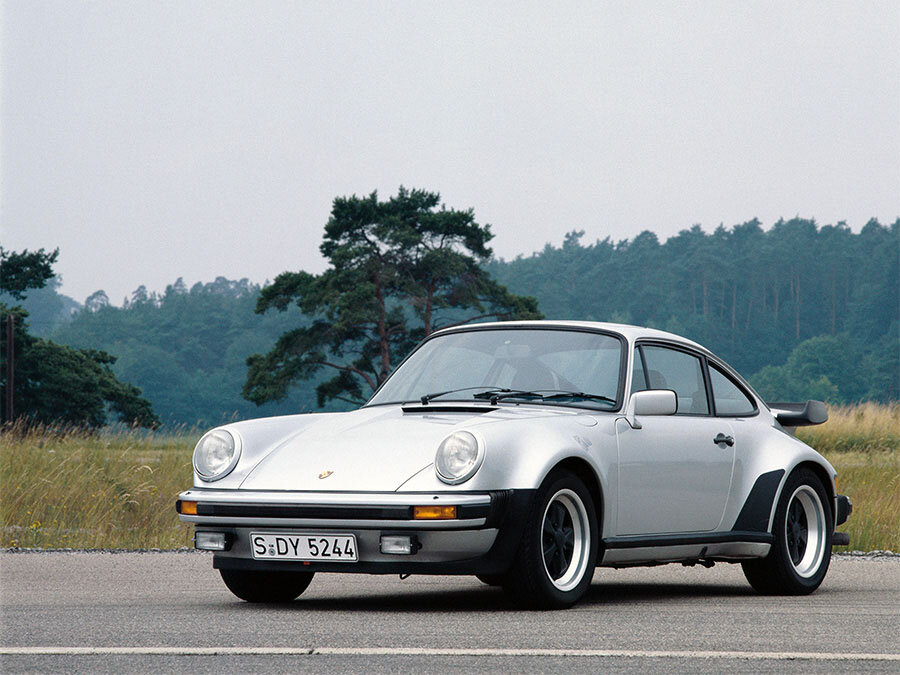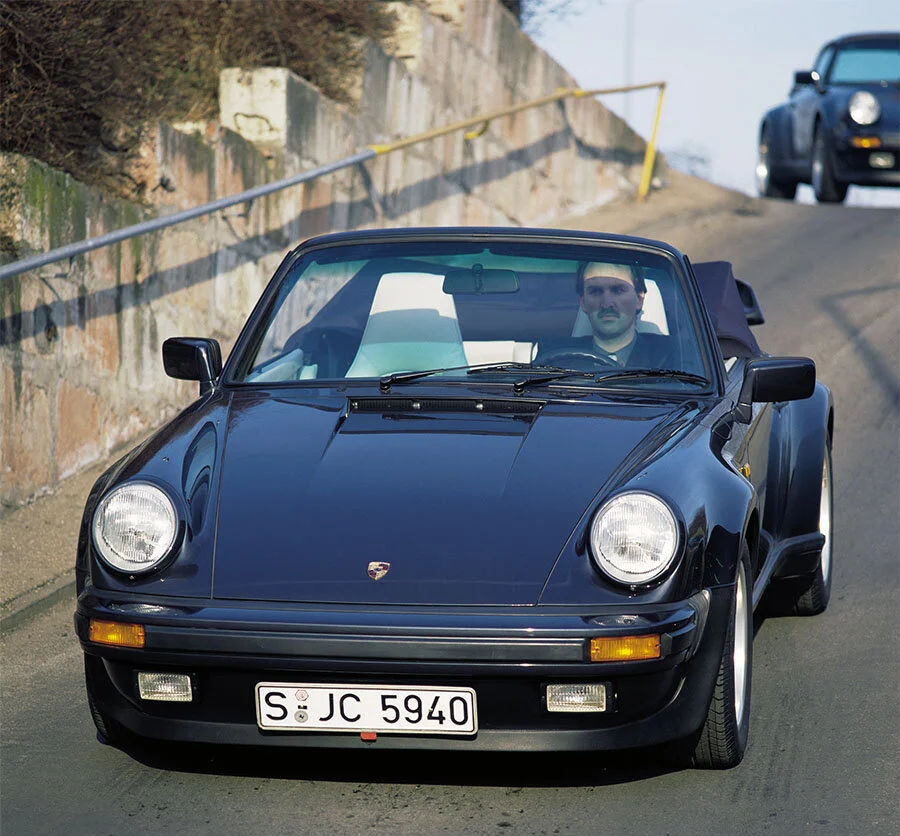Guide: Porsche 911 3.3 Turbo (930) - a Historical & Technical Appraisal
/BACKGROUND
The turbocharged 930 produced from early 1975 was Porsche’s flagship 911 and arguably the most capable supercar of its time.
Performance-wise, the 930 was on a par with anything Ferrari and Lamborghini had to offer. Unlike its Italian rivals though, the turbocharged 911 was practical enough for everyday use and offered bulletproof reliability.
However, the 930 was not without a dark side. Infamous lift-off oversteer led to it being dubbed the Widowmaker, but tales of high-speed death and destruction did little to diminish the car’s ongoing popularity. Indeed, sales massively exceeded expectations.
Porsche had conceptualised the 930 as a limited run of 400 cars that would be built to secure homologation into the Group 4 and 5 racing categories. As had been the case with the firm’s previous homologation special (the 911 2.7 Carrera RS of 1972-1973), demand far exceeded the number required by the FIA.
Unlike the 2.7 Carrera RS, the 930 became a permanent fixture in the Porsche line up.
Upon its 1975 launch, the turbocharged 911 became Porsche’s alternative to the Ferrari 365 GT4 BB and Lamborghini Countach. By late 1977, Ferrari had switched to the torquier 512 BB and, while Lamborghini were on the brink of administration, the wild new Countach S was unveiled in early 1978.
To keep up with the competition, Porsche offered a further uprated 930 from September 1977 (for the 1978 model year).
ENGINE / TRANSMISSION
At the heart of the revised model was its new Type 930/60 motor - another air-cooled all-alloy Flat 6 with two valves per cylinder, single overhead camshafts and dry-sump lubrication.
For this latest application, displacement was increased from 2994cc to 3299cc. Each cylinder had been bored to 97mm (up from 95mm) while stroke was extended from 70.4mm to 74.4mm.
Compression was also increased (from 6.5 to 7.0:1) and a larger but lighter KKK K27 turbo replaced the old 3 LDZ type.
One of the most important upgrades was the addition of an air-to-air instead of water-to-air intercooler. This dramatically reduced charge air temperature.
Other upgrades included enlarged main bearings and beefier big ends.
Fuel-injection and ignition was via the latest Bosch K-Jetronic.
Output figures for the 3.3-litre engine were a considerable improvement. Power went from 260bhp to 300bhp at an unchanged 5500rpm. The torque rating jumped from 253lb-ft to 303lb-ft at an unchanged 4000rpm.
One universal upgrade made across the 911 range for the 1978 model year was a bulky new Porsche-designed rubber-centre clutch that resulted in engines being mounted 30mm further back in the chassis.
The aluminium-cased four-speed gearbox was given new ratios and re-designated Type 930/34.
CHASSIS
Porsche’s steel unibody chassis was unchanged as was the existing fully independent suspension layout.
At the front, Porsche employed a MacPherson strut arrangement with lower wishbones, longitudinal torsion bars and anti-dive geometry. The back end used semi-trailing arms with anti-squat.
Bilstein shocks were fitted all round along with anti-roll bars at either end.
Arguably the biggest criticism aimed at the three-litre 930 was its stopping power. The original Turbo had an arrangement lifted direct from the 2.7-litre Carrera, but this latest 930 was enhanced with 917-derived cross-drilled and ventilated discs with aluminium hubs and finned four piston alloy calipers.
Disc diameter went from 282.5mm to 304mm at the front and 290mm to 309mm at the rear. Disc thickness was also increased.
Right-hand drive 911 Turbos were finally fitted with the Hydrovac brake servo that had been present on left-hand drive examples since late 1976.
Forged light alloy wheels were supplied by Fuchs. They measured 16 x 7-inches at the front and 16 x 8 at the rear. Dunlop or Pirelli tyres were usually issued.
BODYWORK
The only cosmetic change made to these 3.3-litre Turbos was a new rear spoiler which was positioned on a boxier housing to accommodate the bulky air-to-air intercooler.
The main body of the spoiler was also reconfigured. It now featured a flattened top with myriad cooling vents and a thicker rubber surround than before.
That no other visual updates were deemed necessary at a time of rapid design evolution was a testament to the 911’s classic good looks.
INTERIOR
The same was true inside. By this time, the half leather seats with tartan fabric centres and matching door panels were seen less and less as full leather upholstery generally took over.
The familiar five gauge instrument binnacle featured a central tachometer with integrated boost indicator flanked to the right by a speedometer and clock. To the left was a combined oil pressure / oil temperature gauge and a read out for oil level / fuel.
Standard equipment included electric windows, a four-speaker stereo with front wing-mounted electric antenna, a rear wiper, headlight washers and front fog lights.
OPTIONS
Customers could optionally specify a ZF limited-slip differential, rear fog lights, air-conditioning, an electric sunroof and a central console.
At this stage, the 930 was only available as a Coupe.
WEIGHT / PERFORMANCE
Compared to the outgoing variant, the 3.3-litre Turbo was 7mph faster (161mph) and 0.6 of a second quicker from 0-62mph (5.1 seconds).
Weight went from 1195kg to 1300kg.
USA VERSION
As usual, tighter safety and emissions legislation in the USA meant those cars sent across the Atlantic came with several modifications.
All 930 motors were fitted with an air pump to reduce exhaust emissions regardless of destination. However, the ‘49 US-state’ Type 930/61 engine additionally came with thermal reactors while California-bound Turbos used Type 930/63 units further burdened by a vacuum control.
Output of both versions was 265bhp at an unchanged 5500rpm. The torque rating was also slightly lower: 291lb-ft instead of 303lb-ft at an unchanged 4000rpm.
Cosmetic changes to these US-spec. derivatives included amber running lights, red rear indicators and thicker body coloured headlight shrouds. Weight was unaffected but performance figures were slightly inferior.
1978 MODEL YEAR I-SERIES PRODUCTION
Production of the 3.3-litre 930 began in September 1977.
In total, 1757 were built on the 1978 model year I-series platform.
1979 MODEL YEAR J-SERIES
The 1979 model year L-series followed in September 1978.
All cars now came with the extended centre console as standard.
Chequered Pascha upholstery was added to the options list.
US-bound 930s were uprated with air-conditioning at no cost.
In total, 2552 examples were completed.
1980 MODEL YEAR A-SERIES
Instead of 1980 model year 911s adopting the expected K-series moniker, Porsche started from scratch to reflect a new 17 instead of 10-digit chassis numbering system.
These latest A-series 930s came with dual instead of single exhausts and a brass tube oil cooler.
Significantly, the cost of compliance meat Porsche stopped supplying the 930 in the USA and Japan. This had a dramatic affect on sales and just 840 A-series 911 Turbos were manufactured which was less than a third of the previous year’s total.
1981 MODEL YEAR B-SERIES
Production then dropped to 761 units for the 1981 model year B-series derivative which came with seamless steel tubes instead of braided fuel lines and improved diaphragm clutch springs.
A new sports seat with bigger bolsters was added to the options list.
1982 MODEL YEAR C-SERIES
The only significant change made for the 1982 model year C-series 930 was the addition of a new high powered alternator with integrated voltage regulation.
Production rose for the first time in two years and 1027 were built.
1983 MODEL YEAR D-SERIES
For the 1983 model year D-series 930, a series of key developments were introduced.
Porsche’s revised Type 930/66 engine was no larger or more powerful than before but did offer some useful extra torque (up to 318lb-ft from 303lb-ft at an unchanged 4000rpm).
With the aim of reducing emissions, a new exhaust system now featured the wastegate exhaust flowing direct to the atmosphere. The Bosch K-Jetronic came with a new warm-up regulator.
1080 of these D-series derivatives were built, another slight increase on the year before.
1984 MODEL YEAR E-SERIES
Further developments were introduced for the 1984 model year E-series 930.
Changes included a brake wear indicator on the dash, a three-speed heater, a new type of upholstery with Porsche script and revised pressure-fed timing chain tensioners.
Only 881 were assembled, the lowest figure for any full year of production.
1985 MODEL YEAR F-SERIES
Industrial action resulted in the 1985 model year F-series 930 not entering production until October 1984 (instead of September).
The F-series came with thicker anti-roll bars, an enlarged 85-litre fuel tank and bigger brake master cylinder.
Inside, re-designed high-backed seats were heated and electrically operated. Central locking became standard and the radio antenna was integrated to the windscreen.
A short shift gear lever was added along with a new four-spoke steering wheel.
The door handles and storage bin lid were now upholstered with leather.
Sports seats became a no-cost option.
1148 of these 1985 model year 911 Turbos were manufactured, a 34% rise on the previous year.
1986 MODEL YEAR G-SERIES
Production of the 1986 model year G-series 930 got underway in September 1985.
It featured new Bosch LE-Jetronic fuel-injection, 9-inch wide rear wheels (up from 8-inches), a subtly reworked dash fascia, sun visors with covered vanity mirrors and front seats mounted a little lower than before.
Thanks to the arrival of a new emissions friendly Type 930/68 engine, the 911 Turbo was re-introduced to the US market after a five year absence.
Equipped with a three-way catalytic converter, Lambda oxygen sensors and DME engine management, the US-spec. Type 930/68 motor produced 282bhp at 5500rpm and 288lb-ft at 4000rpm.
With the 930 now available in the US again, production surged to 2670 units, over half of which were sent across the Atlantic.
1987 MODEL YEAR H-SERIES
For the 1987 model year, Porsche began to offer the 930 in Targa and Cabriolet body styles as well as the original Coupe format.
At the same time, an 'Exclusive' options programme was officially introduced that enabled customers to specify all kinds of high end modifications.
This most famously included option M505: the Turbo S Flachbau (covered separately).
In addition to Flat Nose bodywork, the M505 package included side skirts, vented rear wheelarches, a deep front spoiler with supplementary oil cooler, a 330bhp engine, four-outlet exhaust and various interior upgrades. These features could also be specified with normal 911 headlights and cars equipped as such are sometimes referred to as Turbo S variants.
Other updates introduced for the 1987 model year included a modified tail reflector strip that incorporated the fog and reverse lights which had previously been located underneath the back bumper.
Inside, fully electric seats were made standard.
The brakes were improved with bevelled vents to assist cooling.
After record sales the previous year, 1987 was even better. 3094 Turbos were sold in various configurations.
1988 MODEL YEAR I-SERIES
This figure dipped to 2784 during the 1988 model year when little was changed in the transition from H to I-series. A passenger door mirror and eight-speaker stereo were made standard but more significant changes were on the way.
1989 MODEL YEAR J-SERIES
For the 930’s final year in production (1989), Porsche switched from the four-speed Type 915 gearbox to the five-speed G50 unit.
An alarm was added along with a smaller rear anti-roll bar (this having been offset by more prominent torsion bars and stiffer shocks).
These 1989 model year J-series 930s were undoubtedly the best of the bunch. 2524 were sold in various configurations.
END OF PRODUCTION
The 1989 figure took total 911 Turbo sales between 1975 and 1989 to just under 20,000 units.
A replacement (the 965) was launched at the Geneva Motor Show in March 1990. It entered production that September for the 1991 model year.
Text copyright: Supercar Nostalgia
Photo copyright: Porsche - https://www.porsche.com






































